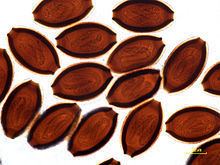Rank Genus | Phylum Nematoda | |
 | ||
Similar Trichosomoididae, Huffmanela ossicola, Huffmanela lata, Huffmanela hamo, Capillariidae | ||
Huffmanela Moravec, 1987 is a genus of parasitic nematodes, belonging to the family Trichosomoididae.
Contents
Morphology
As other nematodes, species of Huffmanela are elongate and vermiform. They are especially thin and small. The male is smaller than the female. The stichosome is composed of a single row of stichocytes (glandular cells). The advances eggs contain larvae and have strongly pigmented, dark, often conspicuously thick walls comprising three layers, and polar plugs.
Biology
Nematodes of the genus Huffmanela are all parasites of fishes. They infect various tissues (skin, mucosa, musculature, swimbladder wall, intestine wall, and even within the bones ) of elasmobranchs (sharks) and bony fishes. The life cycle of the marine species is not known.
Females lay eggs in the host's tissues at a very early stage and eggs continue to develop after being laid. Eggs usually occur as masses in the tissues of the hosts, occurring frequently as conspicuous black spots in the flesh or other organs of fish; these black spots may constitute a commercial problem.
Life Cycle
The life cycle of Huffmanela huffmani, the only species from freshwater, has been elucidated in 2016; it includes amphipods as intermediate hosts. The diagrams shows the steps in the life cycle of Huffmanela huffmani.
The life cycle of marine species is still unknown.
Systematics
In zoology, new species are generally described only from adult specimens; however, in the case of Huffmanela species, it happens that the eggs are often the only stage which is known. For this reason, several species of Huffmanela have been described from eggs only. This is exceptional but perfectly valid for the International Code of Zoological Nomenclature, and eggs are considered syntypes of the new species.
Classification
According to Moravec (2001), Huffmanela is the single genus within the subfamily Huffmanelinae Moravec, 2001.
The type-species of the genus Huffmanela is Huffmanela carcharini (McCallum, 1925) Moravec, 1987, a species originally described as Capillaria carcharhini MacCallum, 1925 and Capillaria spinosa MacCallum, 1926 by MacCallum.
Twenty species of Huffmanela have been described with a binomial name (or Latin name)
Of these 20 species, only 5 have their adult forms known and described (Table below); all others have been described from eggs only. Hosts include a variety of fish species and families (Table below), generally marine, with a single exception, H. huffmani in a freshwater fish host.
In addition to these described species, about half a dozen cases of Huffmanela spp., or unnamed species, have been reported in various fish hosts.
Described species of Huffmanela, description of their adult form, and host fish species and family
Medical interest
All known species of Huffmanela are strictly parasite of fishes, and none can infest humans. However, cases of spurious parasitism have been described in the medical literature from coprological studies. Since infestation of fish are often heavy, with millions of eggs in a single fish, it is understandable that consumption of such an infested fish, even well cooked, can results in numerous eggs in human feces. Because of their polar plugs, eggs of nematodes of the genera Anatrichosoma, Capillaria or Trichuris can sometimes induce misidentifications.
